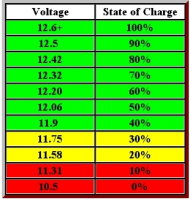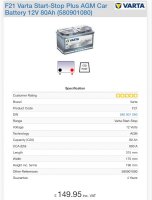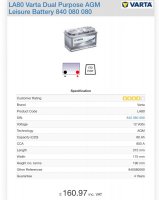- Home
- Forums
- VW California T5 T6 & T6.1 Specific Sections
- VW California T5,T6 & T6.1 Specific Sections
- Electrical
You are using an out of date browser. It may not display this or other websites correctly.
You should upgrade or use an alternative browser.
You should upgrade or use an alternative browser.
andyinluton
Super Poster
VIP Member
- Messages
- 7,731
- Vehicle
- T6.1 Ocean 204 4 motion
I think the theory is quite straightforward; it needs to cycle more often to keep the temperature at a higher setting.
No the reverse - freezing outside, heater set on high it will run constantly
Warm outside, heater on low, heater starts up every half hour runs for a couple of minutes, turns off etc
As its the start up that drains the battery, the first scenario may use less battery power in a night than second.
Loz
Super Poster
Lifetime VIP Member
That’s what I said..No the reverse - freezing outside, heater set on high it will run constantly
Warm outside, heater on low, heater starts up every half hour runs for a couple of minutes, turns off etc
As its the start up that drains the battery, the first scenario may use less battery power in a night than second.
andyinluton
Super Poster
VIP Member
- Messages
- 7,731
- Vehicle
- T6.1 Ocean 204 4 motion
No it isn't,That’s what I said..
You said "it needs to cycle more often to keep the temperature at a higher setting." I said it doesn't cycle on a higher setting, it runs constantly.ie it cycles less
Loz
Super Poster
Lifetime VIP Member
Not what I said but what I meant..
mountainman
- Messages
- 215
- Vehicle
- T7 California Ocean 4 Motion
There was a question somewhere about how long batteries may last. I can provide some anecdotal stuff.
My Cali is now in it's 8th summer, still same batteries and no problem. I am typically operating off batteries only for 4-5 days with 10-20 mile drives at the end of each day. I sometimes leave the van for 3-4 days at a time with the fridge on setting 5. In the less warm months I use the heater for an hour in the morning and a couple of hours at night, usually on setting 3, fridge always on. I only ever start the engine to pop the roof up and down, never to start the heater. Prior to a trip I plug the van in overnight to give the batteries a deeper charge. Just back from walking Glencoe. Got completely soaked on Friday so went to the pub after finding dry clothes but left the van heater on at setting 10! for 4 hours to dry out my boots (expensive, I know). The fridge was on setting 5 too. No problems at all. Hope this provides some calibration.
My Cali is now in it's 8th summer, still same batteries and no problem. I am typically operating off batteries only for 4-5 days with 10-20 mile drives at the end of each day. I sometimes leave the van for 3-4 days at a time with the fridge on setting 5. In the less warm months I use the heater for an hour in the morning and a couple of hours at night, usually on setting 3, fridge always on. I only ever start the engine to pop the roof up and down, never to start the heater. Prior to a trip I plug the van in overnight to give the batteries a deeper charge. Just back from walking Glencoe. Got completely soaked on Friday so went to the pub after finding dry clothes but left the van heater on at setting 10! for 4 hours to dry out my boots (expensive, I know). The fridge was on setting 5 too. No problems at all. Hope this provides some calibration.
WelshGas
Retired after 42 yrs and enjoying Life.
Super Poster
Lifetime VIP Member
Well definitely something wrong. Not on Hookup. IPad Charging. Fridge On.
Compressor kicked in and my Voltmeter with a 12v alarm sounded.
Current draw of 3.8 amps and voltage dropped down to 11.6v. Switched off fridge and voltage climbed to 12.6v.
Have driven 300 miles today. Solar panel shows smiley face so the Batteries maybe accepting the charge but failing under load. So looks like a Battery change at 5 years.
I do use them a lot throughout the year but I think something acute has failed, probably one or more of the cells.
Anyway, if anyone has any recommendations ideally higher rated Batteries would be nice.
Compressor kicked in and my Voltmeter with a 12v alarm sounded.
Current draw of 3.8 amps and voltage dropped down to 11.6v. Switched off fridge and voltage climbed to 12.6v.
Have driven 300 miles today. Solar panel shows smiley face so the Batteries maybe accepting the charge but failing under load. So looks like a Battery change at 5 years.
I do use them a lot throughout the year but I think something acute has failed, probably one or more of the cells.
Anyway, if anyone has any recommendations ideally higher rated Batteries would be nice.
Last edited:
A
andrew bazeley
VIP Member
- Messages
- 343
Hope you don't mind me using this thread (I don't have anywhere near such a big problem - at least I hope not!) to ask about a bit of leisure battery nonsense this weekend. I've been away for four days at a festival with no hook-up, and only using the fridge and radio (which I can magically switch to leisure battery whilst camping). Having replaced both batteries a couple of years ago, they have been lasting under similar conditions for around 4 days. The capacity went down this time to 80% on day two, then 40% on day three. I ran the engine for about 10 minutes, and it went up to 70%. The next morning, it was down to 20%, and the voltage down to around 10. I ran the engine again and the capacity went back up to 90%, and stayed there for the next two days. However, the voltage kept dropping, and ended up around 8.5! Does the voltage necessarily drop with time and consumption, or do I have a problem?You can tell I know nothing about these things!
MartG
I think you've discharged your batteries too far. I wouldn't let them go much below 11.5V for long. Running the engine wont recharge them fully unless you're running for hours, the % indication is probably only a battery terminal voltage which rises on charging and then drops when settled, you've seen the battery % before it's drop and not much charge has gone in, I think. I'd get them onto mains hookup for 24 hours and see.
Yes, voltage will drop as the battery is discharged.
edit - copied from the net...
Yes, voltage will drop as the battery is discharged.
edit - copied from the net...

Last edited:
mountainman
- Messages
- 215
- Vehicle
- T7 California Ocean 4 Motion
Can't answer your question but....how do you switch the radio to leisure battery?
WelshGas
Retired after 42 yrs and enjoying Life.
Super Poster
Lifetime VIP Member
Loz
Super Poster
Lifetime VIP Member
The LA80 is actually 75ah see attached.So, are these 2 Batteries the same, just Marketing and Price Difference?
View attachment 45822
View attachment 45823
Attachments
WelshGas
Retired after 42 yrs and enjoying Life.
Super Poster
Lifetime VIP Member
In fact they both say Battery Capacity 80 amps but the LA80 also says Battery Capacity at 5 hrs is 75 amps.The LA80 is actually 75ah see attached.
I think this is what they are referring to:-
- Discharge rate – The Ah rating provided by the manufacturers of batteries normally assumes a discharge time of 20 hours. The capacity will normally be provided at two or three different levels, such as 95Ah at a 20 hour rate, 80Ah at a 5 hour rate and 105Ah at a 100 hour rate.
MartG
I think you're right. Leisure batteries are designed for lower discharge currents over longer times to a deeper discharge level, compared to a 'car' battery, which is designed for high current discharge but kept relatively fully charged. They have the same Ah rating but probably have different plate thickness as you said. I guess with start / stop technology, the 'car' battery is getting more discharge / charge cycles than they used to.So I presume they might be different internally, eg: thicker plates on the LA80? allowing a deeper charge profile?
Emil Silenhag
- Messages
- 275
- Vehicle
- T5 SE 174
F21 and LA80 are the same battery, yes. Sold under different label...I have used both F21 and LA80 in my California...and my friends California’s...
MartG
So why the price difference - why not buy the cheaper one?F21 and LA80 are the same battery, yes. Sold under different label...I have used both F21 and LA80 in my California...and my friends California’s...
Emil Silenhag
- Messages
- 275
- Vehicle
- T5 SE 174
I bought the cheaper one...
WelshGas
Retired after 42 yrs and enjoying Life.
Super Poster
Lifetime VIP Member
So which one should I go for?F21 and LA80 are the same battery, yes. Sold under different label...I have used both F21 and LA80 in my California...and my friends California’s...
I suppose if the Warranty is to be effective I should use the LA80. At least I would be using it for the described purpose.
Emil Silenhag
- Messages
- 275
- Vehicle
- T5 SE 174
They are the same battery, use whatever you want. I have no warranty on my car, I always go for the cheapest one. 2-3 years ago F21 was cheapest her in Norway, approximately 190 euros and LA80 around 280 euros. The same battery from Vw here in Norway (but in black when it is from Vw) is 430 euros (each!).
Now it is the other way around for some reason and you can find LA80 for 190 euros...
Now it is the other way around for some reason and you can find LA80 for 190 euros...
A
andrew bazeley
VIP Member
- Messages
- 343
Some very clever chaps in a VW specialist in Amesbury reinstalled my Kenwood system (after two cock-ups). and put in a three-way switch in the glovebox (car battery/off/leisure batteries). Whilst I'm getting paranoid now about the leisure batteries running low, I have absolutely no fears now about the car battery running down!Can't answer your question but....how do you switch the radio to leisure battery?
A
andrew bazeley
VIP Member
- Messages
- 343
Thanks for that. I'm wondering if maybe the percentage indicator is at fault; it stayed on around 90% for several hours, while the voltage went right down to just under 9! Either way, do you agree that after 2.5 days with only a fairly high-temperature-setting fridge and the occasional radio, a voltage of less than 9v doesn't look right, and I maybe need the batteries tested/replaced? I think they're still under guarantee. Thanks for your help.I think you've discharged your batteries too far. I wouldn't let them go much below 11.5V for long. Running the engine wont recharge them fully unless you're running for hours, the % indication is probably only a battery terminal voltage which rises on charging and then drops when settled, you've seen the battery % before it's drop and not much charge has gone in, I think. I'd get them onto mains hookup for 24 hours and see.
Yes, voltage will drop as the battery is discharged.
edit - copied from the net... View attachment 45821
MartG
I would say that 9V after 2.5 days light load would be indicating low capacity, but that's assuming that you had a good 100% full charge at the start, which I would recommend using a mains hook-up for 24 hours prior to setting off.Thanks for that. I'm wondering if maybe the percentage indicator is at fault; it stayed on around 90% for several hours, while the voltage went right down to just under 9! Either way, do you agree that after 2.5 days with only a fairly high-temperature-setting fridge and the occasional radio, a voltage of less than 9v doesn't look right, and I maybe need the batteries tested/replaced? I think they're still under guarantee. Thanks for your help.
Assuming 1x 75Ah battery, a load of 7.5A would take a fully charged battery down to around 10.5V in 10 hours, 20 hours for 2x batteries...
Does your display show the current when radio on, fridge running, lights, etc? A I reckon you'd be about 2-4A averaged out which should last 2-3 days continuously on with one battery, 5 days with 2. Not sure what setup you have.
As for the percentage display, I don't know. Maybe some other members here can help. I would think there is a voltage and current measurement calculation done within the control panel to give a 'rough' capacity indication, possibly only based on voltage... Something else to consider is with the wiring mods done, with the control panel current measurement using perhaps the ground return from the 'leisure loads' and you've switched a new feed path to your radio using its chassis ground? Wouldn't be a problem to work, just may not show up in the panel display.
A
andrew bazeley
VIP Member
- Messages
- 343
Lots of interesting things there, and it's beginning to make a bit of sense to a real novice! The current shows around 0.2 amps with just the radio going, and 3.5 when the fridge kicks in. A little more with the lights. So such a rapid reduction in the voltage seems a lot. I always assumed the standard setup on a Cali was the two batteries linked, so your estimate of 4-5 days would seem reasonable to me. I've checked my old receipts, and I rather think only 1 battery was changed 3 years ago (they forgot to look at the second one, so I had to take it back!), which means the other is 11 years old! On balance, I think I'll take it in and get the whole thing checked over. The wiring for the new flexible radio connection might well be affecting things, but I think that from now on I'll keep an eye on the voltage rather than the capacity. I admit that I also tend to rely on a long journey to charge up the batteries, but - from what you and one or two others have suggested - a mains charge for a day before the journey is pretty much essential. Thanks so much for the help. I have a lot to learn!I would say that 9V after 2.5 days light load would be indicating low capacity, but that's assuming that you had a good 100% full charge at the start, which I would recommend using a mains hook-up for 24 hours prior to setting off.
Assuming 1x 75Ah battery, a load of 7.5A would take a fully charged battery down to around 10.5V in 10 hours, 20 hours for 2x batteries...
Does your display show the current when radio on, fridge running, lights, etc? A I reckon you'd be about 2-4A averaged out which should last 2-3 days continuously on with one battery, 5 days with 2. Not sure what setup you have.
As for the percentage display, I don't know. Maybe some other members here can help. I would think there is a voltage and current measurement calculation done within the control panel to give a 'rough' capacity indication, possibly only based on voltage... Something else to consider is with the wiring mods done, with the control panel current measurement using perhaps the ground return from the 'leisure loads' and you've switched a new feed path to your radio using its chassis ground? Wouldn't be a problem to work, just may not show up in the panel display.
WelshGas
Retired after 42 yrs and enjoying Life.
Super Poster
Lifetime VIP Member
New batteries ordered from Tanya.
Similar threads
- Home
- Forums
- VW California T5 T6 & T6.1 Specific Sections
- VW California T5,T6 & T6.1 Specific Sections
- Electrical

About us
The VW California Club is the worlds largest resource for all owners and enthusiasts of VW California campervans.















